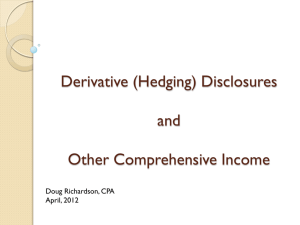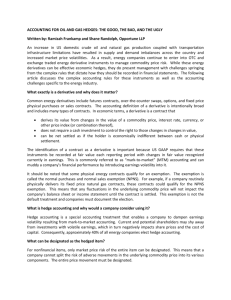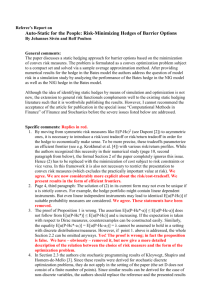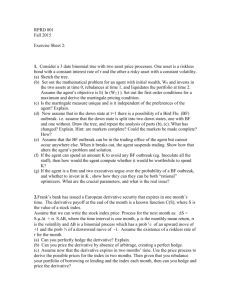Derivatives
advertisement
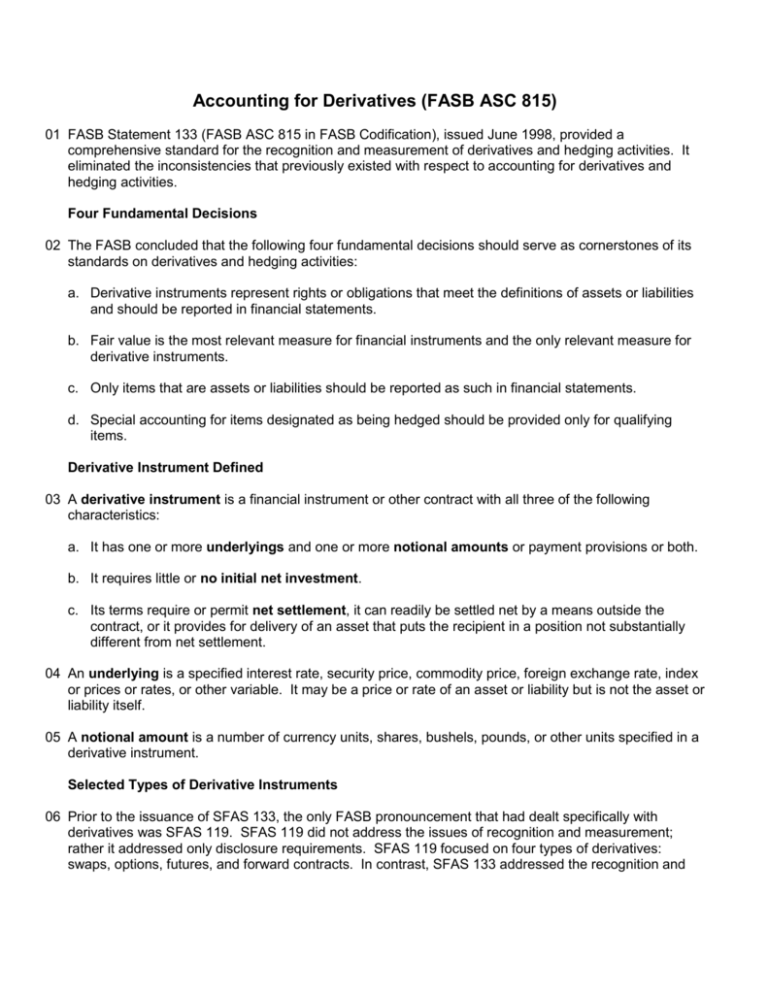
Accounting for Derivatives (FASB ASC 815) 01 FASB Statement 133 (FASB ASC 815 in FASB Codification), issued June 1998, provided a comprehensive standard for the recognition and measurement of derivatives and hedging activities. It eliminated the inconsistencies that previously existed with respect to accounting for derivatives and hedging activities. Four Fundamental Decisions 02 The FASB concluded that the following four fundamental decisions should serve as cornerstones of its standards on derivatives and hedging activities: a. Derivative instruments represent rights or obligations that meet the definitions of assets or liabilities and should be reported in financial statements. b. Fair value is the most relevant measure for financial instruments and the only relevant measure for derivative instruments. c. Only items that are assets or liabilities should be reported as such in financial statements. d. Special accounting for items designated as being hedged should be provided only for qualifying items. Derivative Instrument Defined 03 A derivative instrument is a financial instrument or other contract with all three of the following characteristics: a. It has one or more underlyings and one or more notional amounts or payment provisions or both. b. It requires little or no initial net investment. c. Its terms require or permit net settlement, it can readily be settled net by a means outside the contract, or it provides for delivery of an asset that puts the recipient in a position not substantially different from net settlement. 04 An underlying is a specified interest rate, security price, commodity price, foreign exchange rate, index or prices or rates, or other variable. It may be a price or rate of an asset or liability but is not the asset or liability itself. 05 A notional amount is a number of currency units, shares, bushels, pounds, or other units specified in a derivative instrument. Selected Types of Derivative Instruments 06 Prior to the issuance of SFAS 133, the only FASB pronouncement that had dealt specifically with derivatives was SFAS 119. SFAS 119 did not address the issues of recognition and measurement; rather it addressed only disclosure requirements. SFAS 119 focused on four types of derivatives: swaps, options, futures, and forward contracts. In contrast, SFAS 133 addressed the recognition and measurement issues and specified that any instrument that meets the definition in 03 is a derivative instrument. SFAS 119 and 133 were incorporated in the FASB’s Codification as Topic 815. 07 Even though FASB ASC 815 applies to any instrument that meets the definition of a derivative, the most frequently used derivatives are swaps, options, futures, and forward contracts. Swaps 08 A swap is a contract between two or more parties, referred to as counterparties, to exchange sets of cash flows over a specified period in the future. The two most prevalent types of swaps are interest rate swaps and currency swaps. In the case of an interest rate swap, for example, entity A might have a fixed-rate loan while entity B has a variable-rate loan. The two parties could enter into a contract to swap interest rates. The result would be that entity A would wind up with, in substance, a variable-rate loan and entity B a fixed-rate loan. Options 09 Option contracts allow the holder of the contract to buy or sell a given item at a specific price during a specific period of time. There are two fundamental types of options: call options and put options. A call option gives its owner the right to buy (call) a specific item at a specific price during a specific period of time. A put option gives its owner the right to sell (put) a specific item at a specific price during a specific period of time. 10 For example, if an individual believes that the price of Beta Company’s stock, which is currently selling for $100, will increase, he or she might consider purchasing a call option for 100 shares of Beta Company’s stock at $100. As a result, if the price of Beta’s stock increases, the individual can call (buy) 100 shares at the call price of $100 per share and sell the stock at the higher market price. Futures 11 A futures contract is an agreement between a buyer and a seller, executed through a clearinghouse, that calls for delivery of some commodity or financial instrument at a specified later date at a price established at the time of contracting. The two most prevalent financial futures are foreign currency futures and interest rate futures. Forward Contracts 12 A forward contract is an agreement reached at a point in time that calls for the delivery of a financial instrument or commodity at a specified later date at a price established at the time of contracting. The most widely used forward contracts are those for foreign currency. These contracts are agreements to exchange at a specified future date, currencies of different countries at a specified rate of exchange. Fundamental Measurement and Recognition Requirements 13 An entity must recognize all of its derivative instruments in its balance sheet as either assets or liabilities. Thus, merely disclosing derivative instruments in the notes to the financial statements is unacceptable. They must be measured and the dollar amount included in the column totals of the balance sheet. 14 All derivatives must be recognized on the balance sheet at fair value. Fair value is the amount at which an asset (liability) could be bought (incurred) or sold (settled) in a current transaction between willing parties in other than a forced or liquidation sale. 15 The accounting for changes in the fair value (i.e., gains or losses) of a derivative depends on whether it has been designated as and qualifies for hedge accounting. Types of Hedges 16 FASB ASC 815 allows “special accounting” for the following three categories of hedge transactions: a. Fair value hedges -- hedges of changes in the fair value of assets, liabilities, or firm commitments. b. Cash flow hedges – hedges of variable cash flows of recognized assets or liabilities, or of forecasted transactions. c. Hedges of foreign currency exposures of net investments in foreign operations. 17 The special accounting afforded hedges applies only to the extent that the hedging instrument is “highly effective” in serving as a hedge. For example, if the hedging instrument has a notional amount of $1,500,000 but the asset or liability hedged is only $1,000,000, only $1,000,000 of the hedging instrument is effective in serving as a hedge. The "extra” $500,000 is not effective as a hedge. Instruments that do not Qualify for Hedge Accounting 18 The gain or loss on a derivative instrument that does not qualify as a hedge must be recognized currently in net income. Illustrative Example 19 Assume that the price of commodity X on December 1, 20X1 is $1.00 per pound. Alpha Company believes that the price of commodity X will rise, and on December 1, 20X1 purchases a call option to purchase 100,000 pounds of commodity X at any time within the next three months at $1.05 per pound. Alpha currently does not own any commodity X and does not anticipate the purchase or sale of commodity X in the future except that which would result from the exercise of the call option if Alpha chooses to exercise the option. The market price per pound of commodity X is the underlying and the 100,000 pounds is the notional amount of the contract. Assuming that the price of the call option to Alpha is $2,000, the purchase of the option is recorded on December 1, 20X1 as follows: Option Cash $2,000 $2,000 20 Assume further that as of December 31, 20X1, the balance sheet date, an increase in the price of commodity X has caused the fair value of Alpha’s call option to be $6,500. The $4,500 increase in the fair value of Alpha’s call option is recorded in 20X1 as follows: Option ($6,500 - $2,000) Unrealized gain (included in net income) $4,500 $4,500 21 FASB ASC 815 specifies that gains or losses associated with derivatives that do not qualify as hedges must be included in net income. Since Alpha does not own any commodity X and does not anticipate the purchase or sale of any commodity X in the future (except that associated with the call option), its investment in the call option would not qualify as a hedge. Therefore, the $4,500 unrealized gain resulting from the increase in the fair value of the option (the derivative instrument) must be included in net income. The option is reported on Alpha’s December 31, 20X1 balance sheet as an asset at its fair value of $6,500. 22 Assume that on March 1, 20X2, the expiration date of the call option, the price of commodity X is $1.40 per pound and Alpha elects to exercise the call option. Assume further that Alpha enters into a separate contract to sell 100,000 pounds of commodity X on March 1, 20X2 at the market price of $1.40 per pound. Since the call option expires on March 1, 20X2, the fair value of the option on that date would be equal to the excess of the $140,000 market price of the 100,000 pounds of commodity X over the $105,000 call price (also known as the strike price), or $35,000. The entries on March 1, 20X2 are as follows: Option ($35,000 fair value 3/1/X2 - $6,500 fair value 12/31/X1) $28,500 Unrealized gain (included in net income) [To record the increase in the fair value of the option in 20X2.] Commodity X Cash [To record the exercise of the call option.] $105,000 Cash $140,000 Commodity X Option ($2,000 + $4,500 + $28,500) [To record the sale of commodity X received upon exercise of the call option.] $28,500 $105,000 $105,000 35,000 23 The increase in the fair value was recognized in net income in the periods in which the increase took place, $4,500 in 20X1 and $28,500 in 20X2. Fair Value Hedges 24 Fair value hedges protect against the changes in value caused by fixed terms, rates, or prices. In contrast, cash flow hedges protect against the risk caused by variable prices, costs, rates, or terms that cause future cash flows to be uncertain. 25 For fair value hedges, FASB ASC 815 requires that gains or losses associated with changes in the fair value of the hedging instrument be recognized in net income in the period in which the change in fair value takes place. In addition, changes in the fair value of the hedged item (i.e., the asset, liability, or firm commitment) must be simultaneously recognized in net income and as an adjustment to the carrying amount of the hedged item. 26 For hedged items that absent the hedge would be measured at fair value with changes in fair value reported in other comprehensive income (e.g., available-for-sale securities), the adjustment of the hedged item’s carrying amount should be recognized in net income rather than in other comprehensive income while the hedge exists. 27 For a hedge to qualify as a fair value hedge, certain criteria must be met. The following are perhaps the most important of these criteria. a. At inception of the hedge, there is formal documentation of the hedging relationship and the entity’s risk management objective and strategy for undertaking the hedge. b. Both at inception of the hedge and on an ongoing basis, the hedging relationship is expected to be highly effective in achieving offsetting changes in fair value attributable to the hedged risk during the period that the hedge is designated. c. The hedged item is specifically identified as either all or a specific portion of a recognized asset or liability or of an unrecognized firm commitment. d. The hedged item is a single asset or liability (or a specific portion thereof) or is a portfolio of similar assets or liabilities. e. The hedged item presents an exposure to changes in fair value attributable to the hedged risk that could affect reported earnings. 28 The hedge accounting specified in FASB ASC 815 for a fair value hedge should continue to be used unless one of the following occurs: a. Any required criterion identified in FASB ASC 815 is not met. b. The derivative expires or is sold, terminated, or exercised. c. The entity removes the designation of the fair value hedge. Illustrative Example of Fair Value Hedge 29 On December 31, 20X0, Company D issues at face value a $1,000,000, 8% fixed rate note payable due on December 31, 20X3, with semiannual interest payments on each June 30 and December 31. On the same day, Company D enters into an interest rate swap with Company E for a notional amount of $1,000,000. Under the swap Company D will receive payments based on an 8% fixed interest rate and will pay a variable interest rate based on LIBOR. The swap calls for semiannual settlement with the first settlement on June 30, 20X1 and the last on December 31, 20X3. LIBOR is 7% on December 31, 20X0. 30 Assume that on June 30, 20X1, LIBOR is 6.5% and the fair value of the swap increases to $22,000 and the fair value of the debt increases $22,000. At June 30, 20X1, the following entries are necessary: Interest rate swap (an asset) Gain on hedge activity [To record the change in the fair value of the swap.] $22,000 Loss on hedge activity 8% Notes payable [To record the change in the fair value of the debt.] $22,000 $22,000 $22,000 Interest expense Cash [To record the semiannual interest on the debt at a fixed rate of 8%; that is, $1,000,000 X 8% X 6/12.] Cash Interest expense [To record the settlement on the receive fixed, pay variable interest rate swap [receive $40,000 ($1,000,000 X 8% X 6/12), pay $35,000 ($1,000,000 X 7% X 6/12).] $40,000 $40,000 $5,000 $5,000 31 Note that with the interest rate swap, Company D’s net interest expense is $35,000 ($1,000,000 X 7% X 6/12), which is the amount associated with the variable interest rate (LIBOR), rather than the $40,000 amount that would have been incurred without the swap. 32 The $22,000 change in the fair value of the interest rate swap (the hedging derivative instrument) is included in Company D’s net income. In like manner, the change in the fair value of the outstanding debt (the hedged item) is also included in net income. In the case of a “perfect” hedge such as this one, the change in the fair value of the hedging instrument (the derivative) and the change in the fair value of the hedged item will exactly offset each other. Therefore, the net effect on net income of the changes in these two fair values is zero. 33 The interest rate swap (the hedging derivative) is recognized on Company D’s June 30, 20X1 balance sheet at its fair value of $22,000. The hedged item, the 8% note payable, is reported at what would otherwise be its carrying amount, $1,000,000 in Company D’s case, plus the $22,000 increase in the fair value of the debt. Cash Flow Hedges 34 As mentioned previously, cash flow hedges protect against the risk caused by variable prices, costs, rates, or terms that cause future cash flows to be uncertain, whereas fair value hedges protect against the changes in value caused by fixed terms, rates, or prices. A cash flow hedge is a hedge of an anticipated or forecasted transaction that is probable of occurring in the future but the amount of the transaction has not been fixed. 35 Derivatives designated as hedges of anticipated or forecasted transactions are carried at fair value. The gain or loss resulting from changes in the fair value of the derivative in recognized in other comprehensive income rather than in net income. The change in the fair value of the hedged item is not recognized in the financial statements. 36 For a hedge to qualify as a cash flow hedge, certain criteria must be met. The following are perhaps the most important of these criteria. a. At inception of the hedge, there is formal documentation of the hedging relationship and the entity’s risk management objective and strategy for undertaking the hedge. b. Both at inception of the hedge and on an ongoing basis, the hedging relationship is expected to be highly effective in achieving offsetting cash flows attributable to the hedged risk during the period that the hedge is designated. c. The forecasted transaction is probable and is specifically identified as a single transaction or a group of individual transactions. d. The forecasted transaction is a transaction with a party external to the reporting entity and presents an exposure to variations in cash flows for the hedged risk that could affect reported earnings. e. The forecasted transaction is not the acquisition of an asset or incurrence of a liability that will subsequently be remeasured with changes in fair value attributable to the hedged risk reported currently in earnings. The hedged item presents an exposure to changes in fair value attributable to the hedged risk that could affect reported earnings. 37 The hedge accounting specified in FASB ASC 815 for a cash flow hedge should continue to be used unless one of the following occurs: a. Any required criterion identified in FASB ASC 815 is not met. b. The derivative expires or is sold, terminated, or exercised. c. The entity removes the designation of the cash flow hedge. Illustrative Example of Cash Flow Hedge 38 The following illustration assumes the same facts as those introduced in 29 for a fair value hedge except that the transaction is discussed from the standpoint of Company E rather than Company D. This use of the same set of facts emphasized the similarities and differences between a cash flow hedge and a fair value hedge. Company E initially had a $1,000,000 note payable, issued on December 31, 20X0. The note pays interest semiannually on June 30 and December 31 based on LIBOR. On December 31, 20X0, Company E entered into an interest rate swap with Company D. Under the swap Company E will receive payments based on LIBOR and will pay interest based on an 8% fixed rate. The swap calls for semiannual settlement with the first settlement on June 30, 20X1 and the last on December 31, 20X3. LIBOR is 7% on December 31, 20X0. 39 Assume that on June 30, 20X1, LIBOR is 6.5% and the fair value of the swap decreases to $22,000 and the fair value of the debt has decreased $22,000. At June 30, 20X1, the following entries are necessary: Other comprehensive income Interest rate swap (a liability) [To record the change in the fair value of the swap.] $22,000 Interest expense Cash [To record the semiannual interest on the debt at LIBOR, $1,000,000 X 7% X 6/12.] $35,000 Interest expense Cash [To record the settlement on the receive fixed, pay variable interest rate swap (receive $35,000, pay $40,000).] $22,000 $35,000 $5,000 $5,000 40 The item being hedged by Company E is its variable interest cash flow that is based on LIBOR. Since LIBOR can vary, Company E’s interest cash flow is a variable rather than a fixed amount. Thus the anticipated cash flow is the amount of interest that Company E will pay during the term of the note. (Recall, that from Company D’s standpoint, the future interest cash flow was a fixed amount rather than variable.) 41 With the interest rate swap Company E’s net interest expense is $40,000, which is the amount associated with the fixed interest rate of 8%, rather than the $35,000 amount that would have been incurred without the swap. 42 The $22,000 change in the fair value of the interest rate swap (the hedging derivative instrument) is included in Company E’s other comprehensive income rather than in net income. In addition, the change in the fair value of the note payable is not recognized in the financial statements. 43 If the interest rate swap contract is allowed to remain in effect until the December 31, 20X3 maturity date of the note payable, the fair value of the swap at that date will be zero. Thus, the accumulated other comprehensive income associated with the interest rate swap will be zero at December 31, 20X3. 44 The above cash flow hedge illustration assumes that the interest rate swap is “perfectly effective” in hedging the risk associated with the anticipated future interest cash flows. If that is not the case, the gain or loss associated with the “ineffective” portion would be included in net income rather than in other comprehensive income. For example, if the notional amount of the interest rate swap had been $1,500,000 rather than $1,000,000 (the amount of the note payable), the portion of any gain or loss associated with the $500,000 “extra” notional amount would be included in net income. Hedge of Foreign Currency Exposure of Net Investment in Foreign Operations 45 A derivative instrument or a nonderivative financial instrument that may give rise to a foreign currency transaction gain or loss under FASB ASC 830 can be designated as hedging the foreign currency exposure of a net investment in a foreign operation. The gain or loss on a hedging instrument that is designated as, and is effective as, an economic hedge of the net investment in a foreign operation should be as reported in the same manner as a change in the cumulative translation adjustment, which is a component of other comprehensive income. Thus, a hedge of the foreign currency exposure of a net investment in a foreign operation is reported in a manner similar to that of a cash flow hedge.

